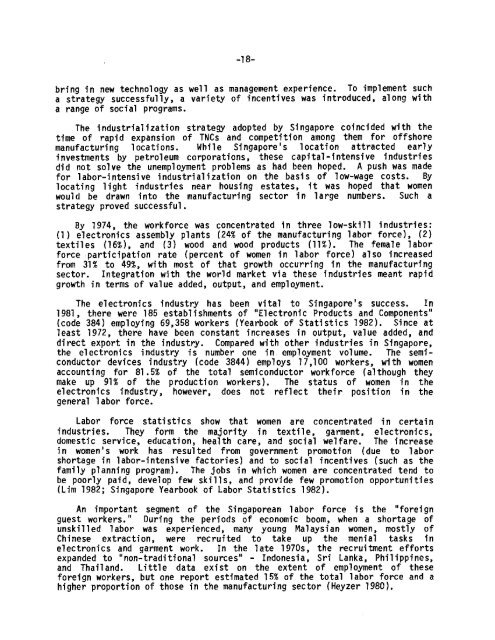Health, Women's Work, and Industrialization - Center for Gender in ...
Health, Women's Work, and Industrialization - Center for Gender in ...
Health, Women's Work, and Industrialization - Center for Gender in ...
Create successful ePaper yourself
Turn your PDF publications into a flip-book with our unique Google optimized e-Paper software.
-18-<br />
br<strong>in</strong>g <strong>in</strong> new technology as well as management experience. To implement such<br />
a strategy successfully, a variety of <strong>in</strong>centives was <strong>in</strong>troduced, along with<br />
a range of social programs.<br />
The <strong>in</strong>dustrial i zati on strategy adopted by Si ngapore coi nci ded wi th the<br />
time of rapid expansion of TNCs <strong>and</strong> competition among them <strong>for</strong> offshore<br />
manufactur<strong>in</strong>g locations. While S<strong>in</strong>gapore's location attracted early<br />
<strong>in</strong>vestments by petroleum corporations, these capital-<strong>in</strong>tensive <strong>in</strong>dustries<br />
did not solve the unemployment problems as had been hoped. A push was made<br />
<strong>for</strong> 1 abor-i ntensi ve i ndustri al i zation on the basi s of low-wage costs. By<br />
locat<strong>in</strong>g light <strong>in</strong>dustries near hous<strong>in</strong>g estates, it was hoped that women<br />
woul d be drawn <strong>in</strong>to the manufacturi ng sector <strong>in</strong> 1 arge numbers. Such a<br />
strategy proved successful.<br />
By 1974, the work<strong>for</strong>ce was concentrated <strong>in</strong> three 1 ow-sk ill i ndustri es:<br />
(1) electronics assembly plants (24% of the manufactur<strong>in</strong>g labor <strong>for</strong>ce), (2)<br />
texti 1 es (16%), <strong>and</strong> (3) wood <strong>and</strong> wood products (11%). The female 1 abor<br />
<strong>for</strong>ce participation rate (percent of women <strong>in</strong> labor <strong>for</strong>ce) also <strong>in</strong>creased<br />
from 31% to 49%, with most of that growth occurr<strong>in</strong>g <strong>in</strong> the manufactur<strong>in</strong>g<br />
sector. Integration with the world market via these <strong>in</strong>dustries meant rapid<br />
growth <strong>in</strong> terms of value added, output, <strong>and</strong> employment.<br />
The el ectroni cs <strong>in</strong>dustry has been vi tal to S<strong>in</strong>gapore's success. In<br />
1981, there were 185 establishments of "Electronic Products <strong>and</strong> Components"<br />
(code 384) employ<strong>in</strong>g 69,358 workers (Yearbook of Statistics 1982). S<strong>in</strong>ce at<br />
1 east 1972, there have been constant <strong>in</strong>creases <strong>in</strong> output, val ue added, <strong>and</strong><br />
direct export <strong>in</strong> the <strong>in</strong>dustry. Compared with other <strong>in</strong>dustries <strong>in</strong> S<strong>in</strong>gapore,<br />
the electronics <strong>in</strong>dustry is number one <strong>in</strong> employment volume. The semiconductor<br />
devices <strong>in</strong>dustry (code 3844) employs 17,100 workers, wi th women<br />
account<strong>in</strong>g <strong>for</strong> 81.5% of the total semiconductor work<strong>for</strong>ce (although they<br />
make up 91% of the production workers). The status of women <strong>in</strong> the<br />
electronics <strong>in</strong>dustry, however, does not reflect their position <strong>in</strong> the<br />
general labor <strong>for</strong>ce.<br />
Labor <strong>for</strong>ce statistics show that women are concentrated <strong>in</strong> certa<strong>in</strong><br />
<strong>in</strong>dustries. They <strong>for</strong>m the majority <strong>in</strong> textile, garment, electronics,<br />
domestic service, education, health care, <strong>and</strong> social welfare. The <strong>in</strong>crease<br />
<strong>in</strong> women's work has resulted from government promotion (due to labor<br />
shortage <strong>in</strong> labor-<strong>in</strong>tensive factories) <strong>and</strong> to social <strong>in</strong>centives (such as the<br />
family plann<strong>in</strong>g program). The jobs <strong>in</strong> which women are concentrated tend to<br />
be poorly paid, develop few skills, <strong>and</strong> provide few promotion opportunities<br />
(Lim 1982; S<strong>in</strong>gapore Yearbook of Labor Statistics 1982).<br />
An important segment of the Si ngaporean 1 abor <strong>for</strong>ce is the "<strong>for</strong>ei gn<br />
guest workers." Dur<strong>in</strong>g the periods of economic boom, when a shortage of<br />
unskilled labor was experienced, many young Malaysian women, mostly of<br />
Ch<strong>in</strong>ese extraction, were recruited to take up the menial tasks <strong>in</strong><br />
electronics <strong>and</strong> garment work. In the late 1970s, the recruitment ef<strong>for</strong>ts<br />
exp<strong>and</strong>ed to "non-traditional sources" - Indonesia, Sri Lanka, Philipp<strong>in</strong>es,<br />
<strong>and</strong> Thail<strong>and</strong>. Little data exist on the extent of employment of these<br />
<strong>for</strong>eign workers, but one report estimated 15% of the total labor <strong>for</strong>ce <strong>and</strong> a<br />
higher proportion of those <strong>in</strong> the manufactur<strong>in</strong>g sector (Heyzer 198D).




